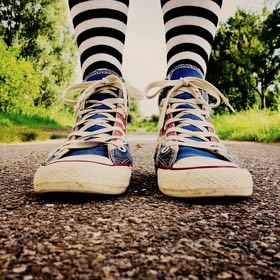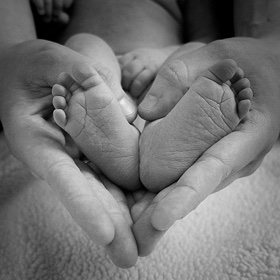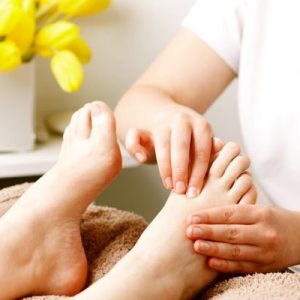
Self-Care experience and advice post ankle surgury and why reflexology is Hayley D’Arcy’s chosen treatment for rehabilitation.
As an ex gymnast, I have sprained my ankles several times. I sprained and dislocated the peroneal tendon in my right ankle in 2016 whilst slacklining and spent the next 18 months trying to rehab it with Pilates; which did reduce the frequency of the dislocation considerably.
I decided however to have surgery in March 2018 as an ultrasound detected a possible tear in the tendon and so every dislocation was potentially increasing my chances of further damage.
I am now two months post op and feel good with my progress. I am regularly seeing a Physiotherapist for manual therapy and Pilates exercises. As a massage practitioner myself, I assumed I would do most of the massage work, but it turns out, mentally it has been a challenge to massage around the scar tissue without apprehension, so this is where reflexology has helped significantly.
Reflexology is one of my favourite treatments to receive; it is deeply relaxing and stimulates the body’s extraordinary self-healing mechanism to help the body function optimally. It encourages the organ systems to work together simultaneously to relax, balance, strengthen and energise.
How many massages have you had, where your primary focus is your back, neck and shoulders? These days touching the feet is  something we hardly ever get to do. Some people even manage to put their shoes and socks on without really coming into contact with them.
something we hardly ever get to do. Some people even manage to put their shoes and socks on without really coming into contact with them.
Historically, to boost a child’s immunity mothers would use oils or herbs on the soles of their feet. How much do we treat out feet? Why not try something new? To benefit from the relaxing and detoxifying effects of magnesium salts, footbaths make a great alternative to baths and absorb enough magnesium through the feet with half the effort and a fraction of the water.
Anatomically, each foot has twenty-six bones, thirty-three joints and over one hundred muscles, tendons and ligaments. Each foot is innervated with over seven thousand nerves. Your feet can feel sensations more acutely than most other body parts. And in my case, the intrinsic benefit of foot rehabilitation through reflexology includes an increased ability to accelerate the breaking up of postoperative and posttraumatic scar tissue. Reflexology can also help to mobilise each tiny bone and joint in the feet and ankles.
What is Reflexology
Reflex ‘an involuntary response to a stimulus’ – Ology ‘the study of’
If you are about to try reflexology for the first time, it is helpful to know the details…or at the very least which part of the body the treatment is performed on and its benefits.
 Reflexology is a non-invasive treatment carried out on the feet or hands. The massage technique involves compression, both firm and light at specific points and regions on the feet, ankles and lower legs. Like acupuncture a type of ‘energy’ flows in channels throughout the body. Each zone on the feet can be considered a channel and manipulating these zones affects the entire channel throughout the body.
Reflexology is a non-invasive treatment carried out on the feet or hands. The massage technique involves compression, both firm and light at specific points and regions on the feet, ankles and lower legs. Like acupuncture a type of ‘energy’ flows in channels throughout the body. Each zone on the feet can be considered a channel and manipulating these zones affects the entire channel throughout the body.
The feet have reflex points in each zone that correspond to specific organ systems. Nerve stimulation creates a physiological response to balance and help in the healing process. Good health is hugely dependant upon balance and the natural effortless functioning of all the body systems.
The body is operated by electrical impulses; messages carried back and forth along neural pathways. Stimulation of nerve endings in the feet send information to the spinal cord and brain. The brain and spinal cord then instruct the organs to function. When these neural pathways are impaired, messages are delivered slowly, unreliably, or in some cases not at all.
By stimulating the nerves in the feet, a reflexologist can encourage the opening and clearing of these neural pathways. By using specific techniques, a practitioner can directly affect the nervous system causing deep relaxation, restored mental alertness, increased circulation and improved immune responses.
Reflexology and Rehabilitation
Scar tissue is tougher and tighter than uninjured tissue because it is difficult for blood to flow through fibrous material. A rich supply of oxygenated blood and nutrients are necessary for repair and reflexology can assist in the delivery of this blood to the injured area.
Reflexology has allowed me to bring my awareness back to the smaller musculature of my feet, ankles and lower legs, therefore acknowledging the tender and perhaps weaker muscles, tendons and ligaments that I must strengthen and stabilise to get back to full function.
My Routine
I started having weekly reflexology after my six-week check-up. I am now able to manipulate and massage the area without it feeling too sensitive. Reflexology has been able to correct the following negative factors of stiffness, soreness, inflammation and tension.
When I’m not having reflexology, I use a tennis ball, spikey massage ball or half coconut shell (anything firmer is too firm at this stage -progress accordingly) to massage the feet. By placing the ball under the foot, I use my body weight to roll it backward and forwards along the surface of the foot.
Reflexology and You
If you are thinking about trying reflexology for general wellbeing and relaxation there has never been a better time. As reflexology benefits the immune system, regular sessions can reduce symptoms of Hayfever. If feeling stressed or tired, fatigued or worried, reflexology can give you an outlet reducing the harmful effects of stress on the body.
Reflexology can encourage healthy blood circulation and help with:
Plantar Fasciitis
Pre and Post Surgery (not just ankle surgery)
Athletes, runners, cyclists…any sports person
New Mothers…all Mums
Sedentary office-based workers
Elderly family members
Women’s & Men’s Health
Headaches and migraines
Reflexology assists the body to produce feel good hormones such as endorphins that block pain.
Reflexology can bring together many different components of rehabilitation and I feel very lucky to be able to receive it and use it to support others in their own self-care.
References
Mackereth, P. (2005). Clinical reflexology. Edinburgh: Churchill Livingstone.
Norman, L. and Cowan, T (1997). The Reflexology Handbook. London: Piatkus.
Ward, G. (2013). What the Foot? A game changing philosophy of human movement eliminating pain and maximising human potential. U.K.:Soap Box Books.



